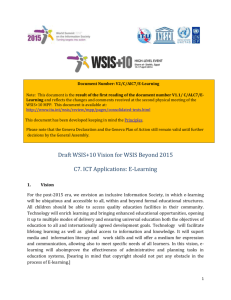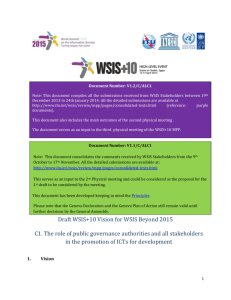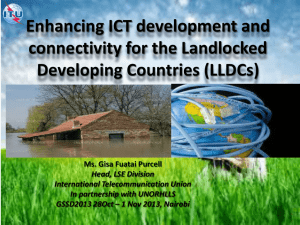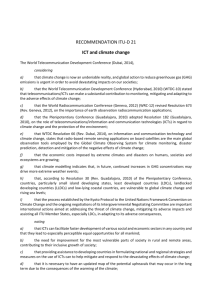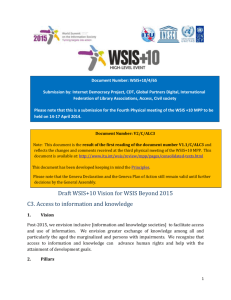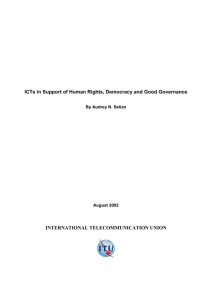Document Number: V1.0/C/ALC6 Note: This document consists of
advertisement
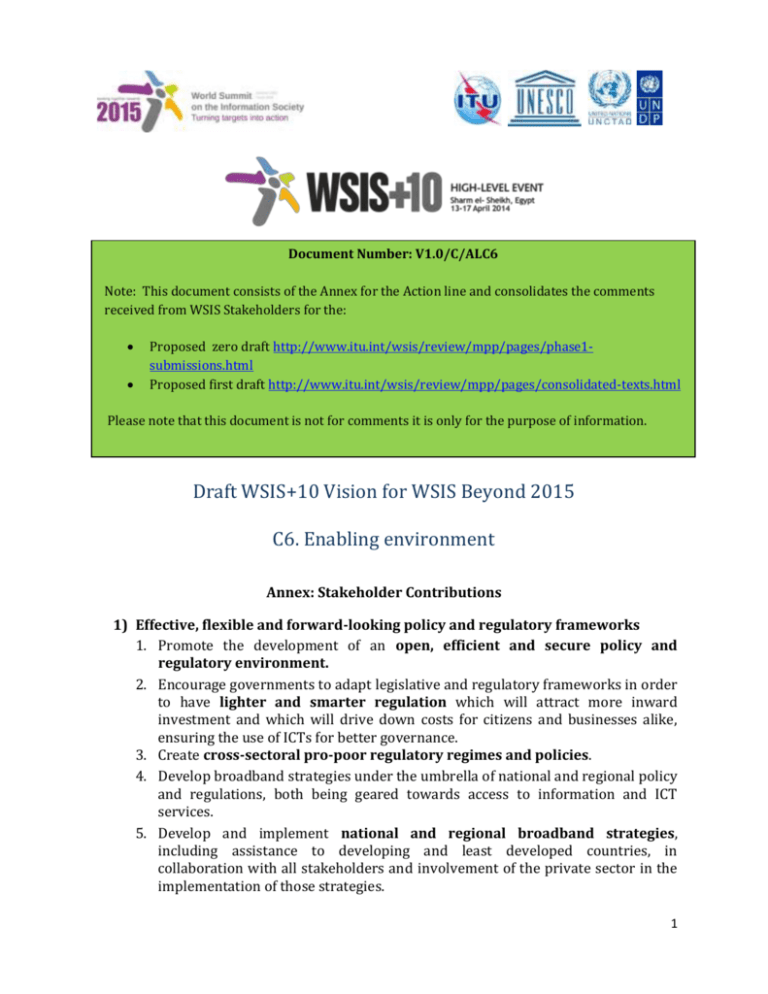
Document Number: V1.0/C/ALC6 Note: This document consists of the Annex for the Action line and consolidates the comments received from WSIS Stakeholders for the: Proposed zero draft http://www.itu.int/wsis/review/mpp/pages/phase1submissions.html Proposed first draft http://www.itu.int/wsis/review/mpp/pages/consolidated-texts.html Please note that this document is not for comments it is only for the purpose of information. Draft WSIS+10 Vision for WSIS Beyond 2015 C6. Enabling environment Annex: Stakeholder Contributions 1) Effective, flexible and forward-looking policy and regulatory frameworks 1. Promote the development of an open, efficient and secure policy and regulatory environment. 2. Encourage governments to adapt legislative and regulatory frameworks in order to have lighter and smarter regulation which will attract more inward investment and which will drive down costs for citizens and businesses alike, ensuring the use of ICTs for better governance. 3. Create cross-sectoral pro-poor regulatory regimes and policies. 4. Develop broadband strategies under the umbrella of national and regional policy and regulations, both being geared towards access to information and ICT services. 5. Develop and implement national and regional broadband strategies, including assistance to developing and least developed countries, in collaboration with all stakeholders and involvement of the private sector in the implementation of those strategies. 1 6. Revisit legal and regulatory framework for new market structures for making broadband services accessible to all. 7. Promote regulatory and policy frameworks, technologies and standards for cloud computing, including addressing security issues. 8. Address number of elements central to an enabling environment for the deployment and adoption of ICTs including privatization of national telecommunications operators; establishment of an separate regulatory authority independent in its decision-making; adoption of Internet neutrality provisions; building a stable investment regime; and creating Internet exchange points, among others. 9. Recognize the access to information and ICTs services as a Human Right and create an enabling environment conducive to the implementation of this principle. 10. Stress the importance of protecting human rights online at all times. 11. Create an enabling environment that respects human rights in the digital environment. 12. Encourage the emergence of a regulatory copyright framework that balances the interests of suppliers and users in order to help business models that are forward thinking when it comes to the way that users want to access, share and remix content. 13. Explore the need to update the current international copyright framework to help libraries and archives preserve cultural products for future generations and protect the public interest. 14. Increase attention to the public interest, particularly relating to the necessary regulatory conditions that will support long-term access to, sharing, and preservation of cultural heritage in digital form. 15. Take actions in order to ensure the proper and unfettered flow of content, information and services in the global network (Internet governance and net neutrality). 16. Harmonize cyber legislation for promoting knowledge society at the regional level, facilitating the cross-border use of e-services, and combating cybercrime. 17. Identify the main difficulties that the digital economy poses for the application of existing international tax rules and develop detailed options to address these difficulties, taking a holistic approach and considering both direct and indirect taxation. Issues to be examined include, but are not limited to, the ability of a company to have a significant digital presence in the economy of another country without being liable to taxation due to the lack of nexus under current international rules, the attribution of value created from the generation of marketable location-relevant data through the use of digital products and services, the characterization of income derived from new business models, the application of related source rules, and how to ensure the effective collection of VAT/GST with respect to the cross-border supply of digital goods and services. 2 Such work will require a thorough analysis of the various business models in this sector. 18. Strengthening the work of the Working Group on Internet governance in an open and inclusive process that ensures a mechanism for the full and active participation of governments, the private sector and civil society of developed and developing countries, including organizations and relevant international and intergovernmental forums, with the purpose of making proposals for action on Internet governance. 19. ITU and other regional organizations should take additional measures to ensure rational, effective and economical use of the radio-frequency spectrum, as well as equitable access by all countries based on relevant international agreements. 2) Open and inclusive policy and regulatory processes 20. Develop smart regulations based on open consultation involving all stakeholders, inclusive of actions and good coordination as regulatory challenges facing developing countries are becoming more complex and cross-cutting. 21. Reexamine and redefine regulatory frameworks to promote digital inclusion ensuring that all communities as well as targeted population groups such as youth, women, persons with disabilities and indigenous peoples can access use ICTs for their social and economic empowerment. 22. Enhance greater collaboration and participation in multistakeholder processes of consumers, with a view of ensuring that their needs are taken into consideration and that they benefit from broadband services. 23. Underline the importance of multistakeholder governance as a critical enabler of economic development and as essential to the achievement of MDGs and the post 2015 development agenda. 24. Take note on the emerging consensus that multistakeholder governance is a necessary component of any process pursuing ICTs and development goals. 25. Ensure that the post 2015 development agenda takes as a central theme the need to establish, at the local, national, regional, and international levels, structures and mechanisms that would allow and encourage multistakeholder governance to flourish. 26. Foster an enabling environment for connectivity requiring an approach based on multistakeholder cooperation. 27. The development of enabling environment is not purely government driven. There should be a greater focus on how governments can learn from the guidance of civil society and business led organizations, many of which already have effective best practices on issues of critical importance to an effective Internet and an inclusive Information Society. 28. International and regional cooperation is indispensable for cybersecurity, standardization, capacity building and Internet governance. 29. Recognize the need for open consultations in creating smart regulations 3 30. Consider issues regarding cross-national governance on topics such as cyber security, and electronic jurisdictions of countries. 31. Promote greater participation and articulation of governments in regional forums for Internet Governance, boosting the development of capacities and the creation of proper analytical frameworks, as well as convergence with organizations of civil society and technical community involved in the debates. 32. Address the need for legal, regulatory, and policy environments that are aimed at fostering ICT investments, recognizing the importance of investment in helping to bridge the Digital Divide. 33. Foster development of good and proper recycling policy, climate policy and processes for cheaper devices being essential ingredients for better governance. 34. Working so that, in the information society, measures are taken to prevent, and refrain from taking, any unilateral measures not in accordance with international law and the United Nations Charter, that impedes the full achievement of economic and social development of the population of the countries concerned, and be contrary to the welfare of their citizens. 3) Competition as means to attract investment and ensure dynamic markets 35. Encourage governments to ensure that their legislative and regulatory frameworks allow for competitive markets to exist, this will help with direct inward investment in ICT infrastructure and services. 36. Pay special attention to development of broadband communication and to creation of favorable competitive environment in developing counties, including least developed countries, small island developing states, landlocked developing countries, as well as countries with economies in transition. 37. Adapt the legislative and regulatory environment to meet new challenges resulting from increased competition, the need for universal service, and new services from IP networks and cloud computing. 38. To remain a key driver of economic growth, the Internet must continue to develop in an open way that allows industries to compete on a level playing field, taking into account that any unnecessary restrictions, such as trade barriers, can inhibit growth. 39. Encourage regulators to monitor ICT traffic (voice, data, etc) through various management techniques, so that they do not discriminate market players. 40. Develop and enforce provisions with regard to network neutrality. 41. Assess the impact of corporate monopolies with regard to the availability and affordability of broadband services. 4) Consumer protection in the information society 36. Take actions to raise consumer awareness on the rights and responsibilities associated with the use of ICTs. 4 37. Increase consumer awareness, to encourage innovative ways to promote resource efficiency and to foster the cooperation between ICT and environmental sectors in the field of greening the ICT sector. 38. Adapt, adopt and enforce cyber legislative and regulatory framework for ensuring confidence and security in the use of ICT for better governance. 39. Enhance national capacities of legislators, judges and lawyers on cyber legislation and organizing awareness workshops on the various aspects of these laws. 40. Develop and update a complete and integrated package of cyber legislation covering all topics related to the use of ICTs and its applications, and that allows building confidence and trust in the use of ICTs, in particular cyber laws related to personal data protection, consumer protection and e-payment. 41. Ensure the safety and reliability of the ICTs, to increase public and business confidence in the use of ICTs; to develop and support a common infrastructure of public authorities and bodies that would guarantee reliable personal identification and verification in the use of ICTs; to create an infrastructure for the management of electronic documents, thus ensuring the authenticity, integrity and preservation of electronic documents. 42. Adopt a strict hierarchical architecture for the public key infrastructure (PKI) set up as it is becoming central to efforts to protect digital identity for individuals and organizations, enabling advanced e-business, e-government and e-commerce activities. 43. Ensure generalized and affordable access to broadband services; 44. Guarantee the safety and protection of users of the various communication tools, and in particular telecommunications networks. 45. Create trust in critical infrastructure through the creation of a professional workforce that has a demonstrated commitment to ongoing continuing professional development, a code of ethics and professional conduct that acknowledges responsibility and accountability to society. 46. Recognize the need to heighten awareness of the benefits and the risks of ICTs. The challenge is to close the gap between evolution of technology and the overall regulatory bodies and the institutional framework. Capacity building must adapt and connect with the speed of the development of technology. 47. This includes the creation of a professional workforce that has a demonstrated commitment to ongoing continuing professional development, a code of ethics and professional conduct that acknowledges the public interest. 48. Give a special importance to children and youth (under 18) as avid consumers of ICTs and the internet and dedicate national programs aiming at securing the online protection of children. 5) Innovation and entrepreneurship as drivers of competition and growth 49. Adopt measures for the creation of adequate policy frameworks which enhance innovation, participation and entrepreneurship in every area of 5 social life and activity. These measures should rely on bold and innovative solutions counting on transparency and input from various stakeholders and from the public at large, they should foster the Internet development and the effective enjoyment of human rights in and through it and not stifle its immense potential. 50. Governments, in collaboration with stakeholders, are encouraged to formulate conducive ICT policies that foster entrepreneurship, innovation and investment, and with particular reference to the promotion of participation by women. 51. Recognizing the economic potential of ICTs for Small and Medium-Sized Enterprises (SMEs), they should be assisted in increasing their competitiveness by streamlining administrative procedures, facilitating their access to capital and enhancing their capacity to participate in ICT-related projects. 52. Promote the creation of incubators and science and technology parks and establish appropriate linkage between research and development institutions, industry and incubators to develop the spirit of innovation and entrepreneurship in the ICT sector. 53. Encourage the establishment of venture capital and funds to promote the creation of start-ups working in the field of ICTs. 54. Investigate crowd-funding and alternative funding mechanisms. 55. Ensure translation of legal and regulatory documents affecting the interests of potential foreign investors into the UN official languages and their publication in Internet. 6) Stimulating the adoption of new and existing ICT services and applications 56. Ensure that regulatory frameworks balance the interests of suppliers and users in areas such as the protection of intellectual property rights, data protection and digital rights management, without disadvantaging innovation. 57. Facilitate the migration to IPv6 and retirement of IPv4. 58. Create a secure and stable platform for the development and storage of information. 59. Define national ICT standards in line with the international ones to guarantee the production of infrastructures and software according to the international standards and to ensure interoperability between different ICT applications and e-government services at national, sub-regional and regional levels. 60. Recognize that effective regulation need to take into account national standards , as well as national conformity and quality management systems. 61. Build national ICT standardization, conformity and quality management system. 62. Raise the awareness on the IPR and related rights. 6 63. Encourage the emergence of a flexible intellectual property framework that balances the interests of creators and users and generates the necessary regulatory conditions to support long-term access to, sharing, and preservation of cultural heritage in digital form. 64. Improve registrations under the national ccTLDs in English and other languages, including local languages. 65. Develop an effective and efficient equipment certification process and ensure adherence to global standards benefits both the industry and users, as it protects the integrity of the telecom networks, guarantees that consumers get standard equipment that work and prevent frequency spectrum interferences. 66. To minimize traffic routing costs, promote the establishment of Internet Exchange Points in collaboration among many actors - including Internet Services Providers, content providers, research networks and other actors. 67. Encourage regulators to secure not only the affordability of access, but also the need to promote and ensure an appropriate level of quality of service (QoS). 68. Promote the use of e-signature methods by enhancing the confidence and security in using such technology, which could be done through adopting efficient legislations and using different mechanisms as developing USB-based authentication token for multiple applications and network services. 69. Facilitate the introduction and expansion of electronic transactions over the internet and the development of efficient security systems in this regard. 70. Governments should act as model users and early adopters of e-commerce in accordance with their level of socio-economic development 7

